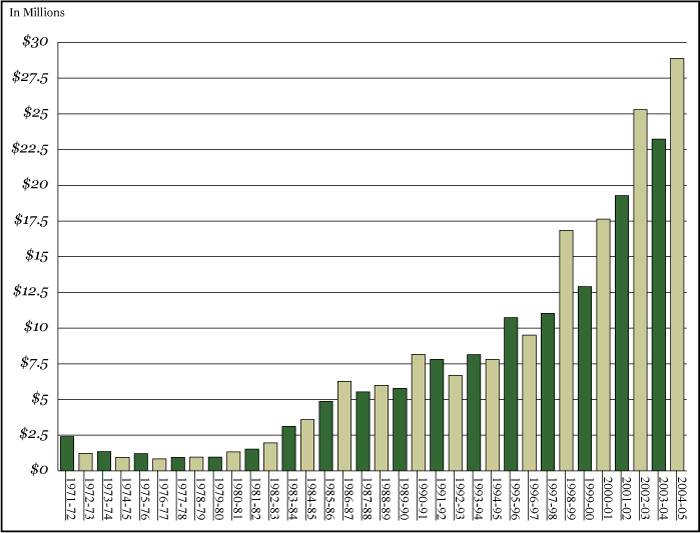Faculty Research and Grants
From 1960 to 1963, 23 grants totaling to $245,995 were received by the University of South Florida. From 1965 to 1970, the number of grants funded increased from 33 to 119 and the amount awarded increased from $516,522 to $3,958,056. Within the USF College of Education, grants were awarded to faculty in the departments of Adult & Vocational Education, Exceptional Child Education, Professional Physical Education, the Dean’s Office, and as well as many other faculty members.
The USF Office of Sponsored Research published its first yearly report of external grants awarded to USF faculty for the 1971-72 school year. According to this report, the College of Education ranked first among the USF colleges, which included the College of Medicine, by receiving $2,408,609 in funding through grants and contracts. This grant funding, which is worth $12,043,045 in the 2006 economy, represented 41 percent of the total external grant funding at USF for the year.
The 1971-72 funding for the College of Education was due in part to several large grants, such as the Trainers of Teachers’ Trainers Project ($164,919), South Florida Teachers Corps In-Service ($150,600), Cycle III $(243,643), Upward Bound ($238,320), Protocol Materials ($107,460), and the Leadership Training Institute ($480, 926). The remaining $522, 613 of funding come from smaller grants in the $20,000 to $50,000 range.
For the following school year, 1972-1973, the College of Education submitted 50 grants proposals. Of which, 37 were funded for a 74 percent rate for total funding of $1,233,899. This total ranked the College of Education second in external funding among all USF colleges.
External funding for the College of Education 1971-2005

For the next 34 years, the College of Education never ranked below fourth among other USF colleges in their yearly amount in dollars from grants and contracts received. A complete listing of the College of Education’s grant and contract totals from 1971 to 2005 can be viewed on the chart describing the 1971-2005 grant and contract funding levels for the College.
Over the next twelve years, the amount of grant funding in the College of Education increased more than three fold. By the 1995-96 school year, over $10,735,100 in funding was secured by the faculty.
Faculty members in the College of Education were recruited for their scholarship and ability to teach, but not for their skills in writing grant proposals. What then is the reason for the unusually high number and amount of grants secured by faculty members in the early years and throughout the history of the College? The most logical explanation is that as young, ambitious faculty members joined the College of Education, they soon realized that if they wanted to conduct research and engage in scholarship beyond the heavy teaching assignments, they would need to do it with external funding. With the rapid growth in enrollment each year, funding based on the previous year’s enrollment was not enough to support any additional activities. Although material support for seeking and securing external funding was limited within the College of Education, each of the College’s deans had an entrepreneurial spirit that encouraged faculty members to engage in grant activities.
Grants to faculty included research, the development of instructional materials, services for K-12 school systems, the participation and validation of evaluation instruments, development of new programs, and graduate assistantships in these programs. The result of these grants had not only local and statewide impact, but national and international influence as well.

